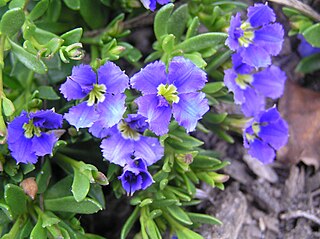Ferenciek tere is a square and junction in Budapest. In addition to being the site of a station on the M3 (North-South) line of the Budapest Metro, it is an important public transport junction for the BKV bus line number 7, which connects Pest and southern Buda.

Goodeniaceae is a family of flowering plants in the order Asterales. It contains about 404 species in twelve genera. The family is distributed mostly in Australia, except for the genus Scaevola, which is pantropical. Its species are found across most of Australia, being especially common in arid and semi-arid climates.

Dampiera is a genus of plants in the family Goodeniaceae which are endemic to Australia occurring in all states. They are herbaceous plants or small shrubs which have blue or purple flowers with yellow centres. The genus is named for William Dampier, an English sea captain and scientific observer. Dampiera diversifolia is sometimes grown in gardens as an ornamental.
Bäk District is situated in the northern part of Khost Province, Afghanistan. It borders Sabari District to the west, Paktia Province and Jaji Maydan District to the north, Pakistan to the east and Tere Zayi District to the south. The population was 19,600 in 2006. The district center is the village of Bäk, located in the southern part close to the border with Tere Zayi District.
Saujana Impian is a township in Hulu Langat district, Selangor, Malaysia. This township is located about 2 kilometres from Kajang town. The Impian Golf & Country Club is located within this township.

Dampiera linearis, commonly known as common dampiera or wedge-leaved dampiera, is an erect perennial herb in the family Goodeniaceae. The species, which is endemic to the south-west of Western Australia, grows to between 15 and 60 cm high, with its blue to purple flowers appearing between July and December. It adapts readily to cultivation, particularly containers such as hanging baskets.

Dampiera stricta is an erect perennial subshrub in the family Goodeniaceae. The species, which is native to Australia, grows to between 0.2 and 0.6 metres in height. It produces blue flowers between August and January in its native range. It occurs in the states of Tasmania, Victoria, New South Wales and Queensland.

Dampiera dysantha, the shrubby dampiera, is an undershrub in the family Goodeniaceae. The species grows to 70 cm high The flowers are blue, or occasionally white to lilac and are covered on the outside with grey and rusty hairs. These generally appear between September and October in its native range.

Papilionanthe Miss Joaquim, also known as Vanda Miss Joaquim, the Singapore orchid, or the Princess Aloha orchid, is a hybrid orchid that is the national flower of Singapore. For its resilience and year-round blooming quality, it was chosen on 15 April 1981 to represent Singapore's uniqueness and hybrid culture.

Dampiera purpurea, commonly known as the mountain- or purple dampiera, is a subshrub in the family Goodeniaceae native to Victoria, New South Wales and Queensland in eastern Australia. Its blue-purple flowers appear in spring and early summer, and it is pollinated by insects such as butterflies and bees. Adapting readily to cultivation, Dampiera purpurea is grown as a garden plant in Australia.

Talostolida teres, common name the tapering cowry, is a species of sea snail, a cowry, a marine gastropod mollusk in the family Cypraeidae, the cowries.

Dampiera diversifolia is a subshrub in the family Goodeniaceae from the southwest of Western Australia.

Dampiera hederacea, commonly known as the karri dampiera, is an erect perennial herb in the family Goodeniaceae. The species, which is endemic to the south-west of Western Australia, is a low spreading shrub which reaches 40 cm (16 in) across. It produces blue flowers between August and January in its native range.
Dampiera altissima, commonly known as the tall dampiera, is an erect perennial herb in the family Goodeniaceae. The species, which is endemic to Western Australia north of Perth.
Dampiera wellsiana is a perennial herb in the family Goodeniaceae. The species, which is endemic to Western Australia north of Perth.
Dampiera eriocephala, commonly known as the woolly-headed dampiera, is an erect perennial herb in the family Goodeniaceae. The species, which is endemic to Western Australia.
Abigail Agivanagi Tere-Apisah is a tennis player from Papua New Guinea.

Dampiera candicans is a plant in the family Goodeniaceae, native to Western Australia and the Northern Territory.

Dampiera dentata is a plant in the family Goodeniaceae, native to Western Australia and the Northern Territory.

Dampiera alata is a plant in the family Goodeniaceae, native to Western Australia.











